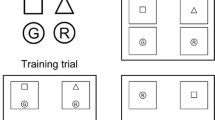Abstract
Four boys living in an institution for individuals with mental retardation participated in a study of the effects of chlorpromazine and thioridazine on discrimination learning. While on their previously prescribed drug, either chlorpromazine or thioridazine, the boys were trained on visual discrimination problems using multiple and concurrent schedules until their rate of learning new problems was stabilized. They then learned a series of new problems while taking only placebo tablets, and finally learned a further series of problems while receiving the alternative drug. Results showed that both drugs elevated discriminative performance relative to placebo. On multiple schedules the drugs increased a discriminative index based on response rate; on concurrent schedules they increased a discriminative index based on stimulus duration.
Similar content being viewed by others
References
Aman, M. G. (1984). Drugs and learning in mentally retarded persons.Advan. Hum. Psychopharmacol. 3: 121–163.
Aman, M. G., and Singh, N. N. (1980). The usefulness of thioridazine for treating childhood disorders: Fact or folklore?Am. J. Ment. Def. 84: 331–338.
Aman, M. G., & Singh, N. N. (1988).Psychopharmacology of the Developmental Disabilities, Springer-Verlag, New York.
Aman, M. G., and Singh, N. N. (1991). Pharmacological intervention: An update. In Matson, J. L., and Mulick, J. A. (eds.),Handbook of Mental Retardation (second edition), Pergamon Press, New York, pp. 347–372.
Beale, I. L., and Winton, A. S. W. (1970). Inhibitory control in concurrent schedules.J. Exp. Anal. Behav. 14: 133–137.
Boren, J. J. (1966). The study of drugs with operant techniques. In Honig, W. K. (ed.),Operant Behavior: Areas of Research and Application, Appleton-Century-Crofts, New York, pp. 531–564.
Breitmeyer, J. M. (1969).Effects of thioridazine and methylphenidate on learning and retention in retardates, Unpublished Masters thesis, University of Illinois.
Heal, L. W., and Johnson, J. T. Jr. (1970). Inhibitory deficits in retardate learning and attention. In Ellis, N. R. (ed.),International Review of Research in Mental Retardation (Vol. 4), Academic Press, New York, pp. 107–150.
Honig, W. K., and Beale, I. L. (1975). Stimulus duration as a measure of stimulus generalization.J. Exp. Anal. Behav. 25: 209–217.
Lipman, R. S. (1970). The use of psychopharmacological agents in residential facilities for the retarded. In Menolascino, F. J. (ed.),Psychiatric Approaches to Mental Retardation, Basic Books, New York, pp. 387–398.
McAndrew, J. B., Case, Q., and Treffert, D. A. (1972). Effects of prolonged phenothiazine intake on psychotic and other hospitalized patients.J. Aut. Child. Chiz. 2: 75–91.
Singh, N. N., and Beale, I. L. (1978). Attentional changes during discrimination learning by retarded children.J. Exp. Anal. Behay. 29: 527–533.
Singh, N. N., and Ellis, C. R. (1992). Psychopharmacology of self-injury. In Luiselli, J. K., Matson, J. L., and Singh, N. N. (eds.),Self-Injury: Assessment, Analysis and Treatment, Springer-Verlag, New York, pp. 307–351.
Singh, N. N., and Winton, A. S. W. (1989). Behavioral pharmacology. In Luiselli, J. K. (ed.),Behavioral Medicine and Developmental Disabilities, Springer-Verlag, New York, pp. 152–179.
Sprague, R. L., Barnes, K. R., and Werry, J. S. (1970). Methylphenidate and thioridazine: Learning, reaction time, activity and classroom behavior in disturbed children.Am. J. Orthopsychiatry 40: 615–628.
Sprague, R. L., and Baxley, G. B. (1978). Drugs for behavior management, with comments on some legal aspects. In Wortis, J. (ed.),Mental Retardation and Developmental Disabilities (Vol. 10) Brunner/Mazel, New York, pp. 92–129.
White, A. J., and Aman, M. G. (1985). Pimozide treatment in disruptive severely retarded patients.Aust. New Zeal. J. Psychiatry 19: 92–94.
Zeaman, D., and House, B. J. (1963). The role of attention in retardate discrimination learning. In Ellis, N. R. (ed.),Handbook of Mental Deficiency, McGraw-Hill, New York, pp. 159–223.
Author information
Authors and Affiliations
Rights and permissions
About this article
Cite this article
Beale, I.L., Smith, O.A. & Webster, D.M. Effects of chlorpromazine and thioridazine on discrimination learning in children with mental retardation. J Dev Phys Disabil 5, 43–54 (1993). https://doi.org/10.1007/BF01046597
Issue Date:
DOI: https://doi.org/10.1007/BF01046597




